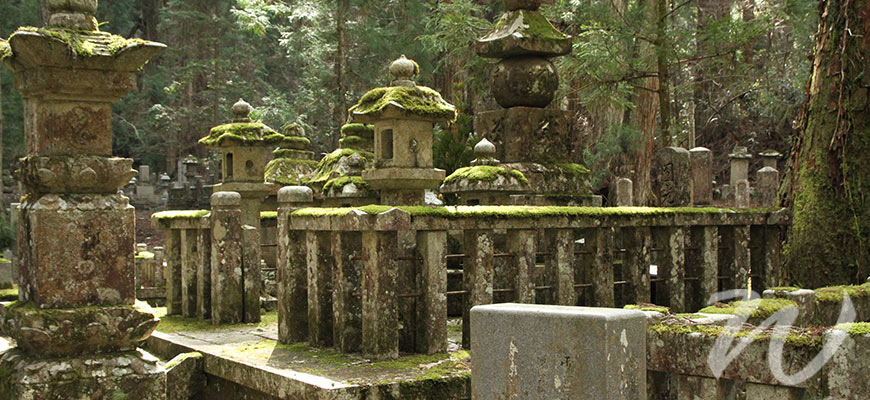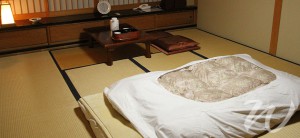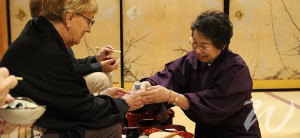The hairs on the back of my neck stand up and tears well in my eyes. Not a reaction I’m accustomed to at 6am. Cloaked in saffron, he leans purposefully over a mass of candles and Sanskrit papers. The solemn deep hum of chanting begins. I don’t know the lyrics to this spiritual soundtrack but I am entranced.
Only 24 hours earlier all western comforts and customs were left in Kyoto. I am off to stay in a shukubo (Buddhist temple lodge) on Koyasan, a secluded mountain-top temple town, located south of Osaka. Journeying several hours by coach up sweeping bends, passing red torii gates and groups of pilgrims on foot lining the sides of the road, I sense a shift in the atmosphere. Is it altitude? Or something more ethereal? Koyasan is the heart of Shingon Buddhism in Japan, established more than 1,200 years ago by Kobo Daishi, a Buddhist monk who built the sacred temple complex on Koyasan. His eternal residence is a mausoleum in nearby Okunoin cemetery nestled amongst ancient cedar trees.

Okunoin Cemetery at Mount Koya
My shukubo is in a peaceful street not far from the cemetery. There is a sense that even the blooming cherry blossoms and chirping birds are searching for something. For according to the teachings of Shingon Buddhism, enlightenment is not a distant reality that can take lifetimes to reach, but a real possibility within this life if one’s spiritual potential (Buddha-nature) is cultivated through teachers and spiritual training.
After a warm greeting from several young monks, shoes are abandoned at the door. “You are welcome” says a dignified older lady after taking a deep bow. I later find out that monks within this sect are permitted to marry and our greeter was the wife of one of the senior monks.
I am lead through a series of hallways, passing bonsai, rock gardens and ornate screen doors to reach my room. A small table, cushions, a delicate tea set and a network of tatami mats await as I slide back the paper-thin door. Outside the bay window is a forest of cedar trees, a small shrine and a snaking mandala of raked stones.

Traditional room arrangement
As I sip my warm green tea, something catches my attention – silence. Absolute silence. At first, mild panic sets in. What am I going to do all night with no TV or bar? What have I walked barefoot into? I take some deep breaths and decide to brave the shared onsen (hot spring bath). I disrobe from my yukata (cotton kimono), following the bathing etiquette and sit in the steaming hot water. Relaxing and reflecting… but only for a few moments. The water is so hot you can only tolerate it for a short period.
Dinner is served at 6pm sharp. In Japan each meal is an adventure in itself and the shojin ryori (devotion cuisine) served here is no exception. It is simple, but fresh and tasty. Several colourful and delicate vegetarian courses are presented as I sit cross-legged at our mini-tables a few inches above the floor. Silken tofu, warming miso soup, fresh vegetables and a steaming hotpot satisfy our hunger. The monk’s wife appears and offers warm sake, which of course, I accept.

Sharing warm sake, Koyasan
When I return to my room, my futon bed is laid out and is covered with a cloud-like quilt. I am asleep by 8.30pm.
I awake before sunrise to the sound of gongs. The worship hall is a sacred space, so cameras are not allowed. A small group of guests are seated in the pews and several monks are seated in front of the altar. I haven’t seen many of them during my stay, but I appreciate I am in their temple and home – they are not here to entertain.
The room is dark, lanterns hang from the ceiling and there are hundreds of gold Buddha statues. Deep chanting of a sutra (sacred scripture) begins. It is as if the previous evening of quiet reflection was preparation for the significance of this moment. The chanting becomes more zealous over the next twenty minutes, culminating in the Goma, a fire ritual unique to this sect of Buddhism. The fire is believed to have a powerful cleansing effect. A pyre is constructed and the flames grow before our eyes. Soon they are licking the ceiling of the ancient wooden temple as the head monk adds fuel, rocking and chanting at the flames, seemingly encouraging them to grow.
Around twenty minutes later the bonfire is snuffed and the chanting takes on a more meditative tone, before concluding peacefully.
The head monk stands and addresses his guests in Japanese. Someone translates and he asks where I am from. I mention Australia and he smiles and responds in broken English, “You are very welcome here. Tell your Australian friends, please come visit us”.
Are you planning a trip to Japan in 2016? Refer to our website to find out more about our group tours and Short Stay travel options to Japan.
